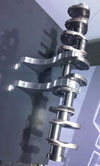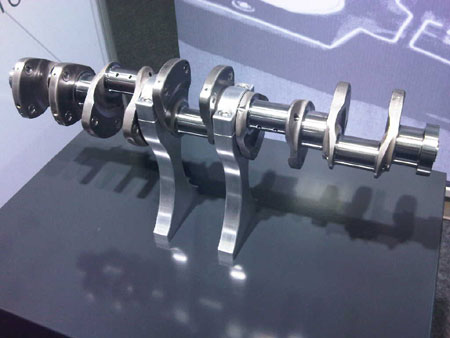Crankshaft Oiling
 In a previous article discussing the oil holes which are necessary in crankshafts, the author briefly discussed one of the methods by which oil is transferred to the crankpins for the purpose of lubricating the big end of the con rod and its bearings. The article discussed how the oil, having arrived at the main bearing, must make its way through the crankshaft via the oil drillings to the crankpin. We touched briefly on compound-angle drillings and axial drillings in that article, but didn't mention a method of crankpin oiling which has been in service for many decades, but which has in recent years become de rigeur in Formula One, and is becoming widely used elsewhere.
In a previous article discussing the oil holes which are necessary in crankshafts, the author briefly discussed one of the methods by which oil is transferred to the crankpins for the purpose of lubricating the big end of the con rod and its bearings. The article discussed how the oil, having arrived at the main bearing, must make its way through the crankshaft via the oil drillings to the crankpin. We touched briefly on compound-angle drillings and axial drillings in that article, but didn't mention a method of crankpin oiling which has been in service for many decades, but which has in recent years become de rigeur in Formula One, and is becoming widely used elsewhere.
The concept of the 'nose-feed crankshaft' is not a new one, being used in some production engines, and having been successfully employed on the Rolls-Royce Merlin engine. The idea is a simple one; oil is pumped into one end of the crankshaft (normally called the 'nose' end, hence the name) and the pressure in the oil system forces it along the crankshaft through a continuous gallery. There are many forms that this gallery can take, but a great many such crankshafts employ angled drillings which enter the web cheeks at an angle in the side of the crankpin and continue through to the crankshaft centreline where they meet a drilling from an adjacent crankpin.
There is a feeling that the oil pressure in the crank oiling lubrication circuit can be maintained at a lower level than with a crankshaft being fed via the main bearing, owing to the fact that there are no centrifugal forces to overcome in order to move the oil initially toward the crankshaft centreline, and no viscous forces in the main bearing opposing the flow of oil into the oil hole. In running a lower oil pressure in the crank oiling circuit, there can be a number of gains to be had in terms of reduced friction from various sources.

However, we have to be mindful of other factors when deciding to provide oiling by this method. We need to be sure that, given our new lower oil circuit pressure and the fact that we are oiling each and every crankpin from a single source, we can provide sufficient flow to the crank such that the furthest pin from the oil entry to the crankshaft receives sufficient flow to satisfy its lubrication needs. Pressure losses in the galleries can be significant and need to be taken account of in this regard. Given this concern, we also need to decide if we continue to lubricate the main bearings from the main oil gallery, or via the flow that we have provided through the crankshaft. Each solution has its own merits and pitfalls. The accompanying picture of a V10 Formula One crankshaft has no sign of oil holes on the main bearing diameters. We can therefore presume that it is a nose-feed type, as we might reasonably expect.
There are certain advantages, besides lower oil pressure to the nose-feed crankshaft; one of these is that we can take advantage of the centrifugal forces present to help increase the quality of the oil flow by providing both scope for de-aeration of the oil flow and filtration.
Fig. 1 - Echoing contemporary design trends, this V10 F1 crankshaft is of the nose-feed type.
Written by Wayne Ward